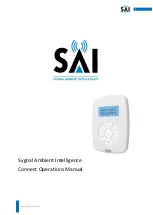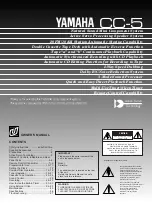
MITSUBISHI ELECTRONICS AMERICA, INC.
ST200 Series Technical Support Manual
43
January 2000
Occupant and vehicle safety must be accorded absolute priority over all other considerations
when installing the Mitsubishi MT. The Federal Motor Vehicle Safety Standards require that
objects installed in a vehicle be placed in such a manner that they will not cause injury to the
vehicle's occupants if the vehicle is involved in a accident. These rules also require that the
function of any vehicle safety system, for example, the seat belts and their attachment hardware,
not be impaired in any manner by any device installed in the vehicle.
Unlike older vehicles, modern vehicles contain a great deal of electronic equipment. Much of
this electronic equipment directly affects the operation of the vehicle itself (engine management
computers, heating/AC controllers), vehicle safety systems (air bag impact sensors and inflation
controllers) or both (anti-lock brake system or traction control system computers). These
electronic devices generate RF energy and are affected by externally generated RF energy.
Vehicle manufacturers take great care to design their vehicles and systems to minimize both
radiated RF energy and reduce the susceptibility of the vehicle’s electronics systems to external
RF energy. However, if the operational integrity of the vehicle is to be preserved, the following
basic guidelines must be observed when installing the MT system (or any
device that generates
RF energy) in a vehicle. Vehicle manufactures have issued guidelines and precautions that are
specific to a their particular make and/or model of vehicle which must be observed. Information
regarding vehicle-specific guidelines can be obtained from the vehicle manufacturer's Technical
Assistance Department.
Basic Rules:
1.
No portion of the MT should be mounted within 6 inches (15 cm) of any computer or
controller module, sensor or other existing electronic device.
2.
No portion of any transmitting antenna, its integrated Radio Frequency Unit (RFU) or
Transceiver should be placed within 12" (30 cm) of any computer or controller module,
sensor or other existing electronic device in the vehicle.
3.
Wires or cabling for the subscriber unit should be routed as far from existing vehicle
cabling as possible, and in no event should they be placed next to or be routed in parallel
with the cabling for any vehicle system.
4.
Whenever a cable is routed either through or over a metallic object, the cable must be
protected against damage with an insulating medium.
5.
Any connection to the existing vehicle electrical system must be done in a manner, and
using components, approved by the vehicle manufacturer.
6.
All connections to the vehicle's power distribution system must be fused.
7.
After the installation has been completed, but before the vehicle is released to the
customer, the installer must verify that the functioning of all vehicle systems has been
unaffected by the subscriber unit installation.
8.
If an MT is interfering with the functioning of ANY vehicle system it must be disabled
until the interference problem is resolved.
Performing a “pre-check” of the customer's vehicle before the installation will identify any pre-
existing problems with the vehicle. Customers are not always aware of the functional state of all
parts of their vehicle, and it is very easy for the customer to blame the installer for (as an
example) a malfunctioning cruise control system, if the vehicle has not been checked out before
the installation has started.
















































